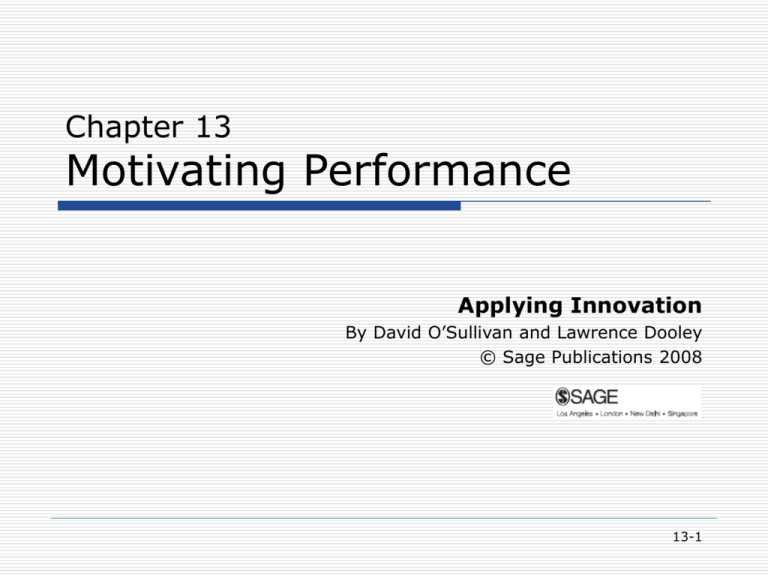
Chapter 13
Motivating Performance
Applying Innovation
By David O’Sullivan and Lawrence Dooley
© Sage Publications 2008
13-1
Reflections
What is a team, and how does it differ from an
organization or community?
What can organizations do to create a successful
team environment?
Name the four different types of teams that can be
used for managing projects.
Explain the terms fully empowered and enabled in
regard to team members.
List a number of ways in which creativity can be
improved in teams.
What technologies can be used to support virtual
teams?
What is a community of practice?
13-2
Activities
[Discussion of selected student
‘Activities’ from previous chapter]
13-3
Learning Targets
Examine the role of motivation in influencing
individual behaviour
Understand the difference between intrinsic and
extrinsic motivation
Outline the process of linking individual performance
to organizational
performance
Describe a number of techniques for sharing rewards
with all team members
Understand the performance appraisal technique
Explain the training and development approach in
relation to motivation
Design a simple performance appraisal system
13-4
Motivation
Creativity: Expertise, Creative
Thinking and Motivation (Amabile,
1998)
Maslow: self-fulfillment, ego or
esteem, social, safety, and
physiological needs.
Theory x – authoritarian
Theory Y – participative
Intrinsic and Extrinsic motivation
13-5
Intrinsic Motivation
From within the individual
The most powerful type of motivation
Inherent desire to perform better
Difficult to manage
Organizations need to hire self
motivated people, provide training
and opportunity and provide a
challenging work environment
13-6
Forces against Intrinsic Motivation
People are often risk averse and tend to
remain within a certain comfort zone rather
than stretch beyond it.
The intrinsic needs of the person and those
of the organization may not align.
People need to fulfill all of Maslow’s needs,
and lower needs are not adequately met by
intrinsic motivation and instead require
extrinsic motivation.
13-7
Extrinsic Motivation
From outside the individual
Financial incentives, additional holidays,
etc.
Useful up to a ‘saturation’ point beyond
which free time and self-development
become important
Popular systems:
Gain sharing
Profit Sharing
Performance Appraisal
13-8
Gain Sharing
Group bonus scheme where entire
organisation benefits from improved
innovation
Individual remuneration linked with
organisational performance
Some individuals rewarded for little effort
Based on an agreed formula:
If labor costs are below 12% of sales then bonus
awarded amounting to 60% of difference
between actual costs and 12% target
13-9
Profit Sharing
Bonuses based exclusively on profits.
If profits increase then bonus
awarded on agreed formula
Difficulty when profits are affected by
factors outside control of organization
Changing share prices
Currency fluxuations
Materials costs
13-10
Benefits of Gainsharing
Coordination, teamwork, and sharing of knowledge
increase.
Social needs are recognized via participation and
mutual reinforcing of group behavior.
Attention is focused on goals such as performance
indicators.
Change due to technology, market, and new methods
gains acceptance.
People demand better performance from each other.
Innovation increases.
Where unions are present, union–management
relations become more flexible.
13-11
Performance Appraisal
Reward or recognition based on individual
performance
Linking goals and actions to individuals
i.e. individual responsible for particular goals or
contributing to particular ideas or projects
Typical linkages around:
Objectives
Indicators
Skills – technical, personal and interpersonal
Ideas and Projects
13-12
Performance Appraisal - sample
13-13
Training and Development
Individuals developed through job design,
task delegation, skills training and career
development
Identification of skills available and required
Identification of mechanisms for improving
skills
E.g. courses, manuals, etc.
Planning development of skills within
organisations through training plan
13-14
Summary
Examine the role of motivation in influencing
individual behaviour
Understand the difference between intrinsic and
extrinsic motivation
Outline the process of linking individual performance
to organizational
performance
Describe a number of techniques for sharing rewards
with all team members
Understand the performance appraisal technique
Explain the training and development approach in
relation to motivation
Design a simple performance appraisal system
13-15
Activities
13-16
Search Online
http://mitworld.mit.edu/
Why Bad Things Happen to Good
Technologies (John Sterman)
Stuck: Why It’s So Hard to Do New
Things in Old Organizations (Rebecca
Henderson)
Building Growth: Why Don’t We Use
What We Know (Rebecca Henderson)
13-17
Copyright
Copyright © 2009 Sage Publishing, Inc. All rights
reserved. Reproduction or translation of this work
beyond that permitted in Section 117 of the 1976
United State Copyright Act without the express
written permission of the copyright owner is unlawful.
Request for further information should be addressed
to the Permissions Department, Sage Publications,
Inc. The purchaser may make back-up copies for
his/her own use only and not for distribution or
resale. The Publisher assumes no responsibility for
errors, omissions, or damages, caused by the use of
these programs or from the use of the information
contained herein.
13-18






